Twenty or so of the best chefs in the world descend on the Carolina Lowcountry to think, drink, eat and repeat.
The barbecue is an astonishment even before Bill Murray shows up. Ticket-holders have come from as far away as Chicago just to eat for a few hours at a dozen or so pop-up stands on a clearing at Bowen’s Island outside of Charleston. This is the final event in a week of Cook it Raw, a think-and-drink-and-cook retreat that takes some of the world’s best chefs to a different fulgent foodspot around the globe each year, and the crowd has gotten just exactly what was promised—a jumble of international food stars at play. April Bloomfield, the Spotted Pig savant who is now moving successfully westward into San Francisco, is on one side plating dishes and chitchatting with the tourists. Eric Werner of the hyper-sustainable Hartwood in Tulum, Mexico, and Albert Adrià of everything everywhere in Barcelona are at the station next to hers and have cracked open a massive squash, hoisting it alongside a giant scored fish on the grill until both amberjack and gourd are blackened and cracking. Canadians are cooking soul food, a choice that had stirred controversy—why the fuck would you come from the north to the south to make cornbread?, asked a fellow northman. But the hand-fired flour-and-hay plates topped with pitch-perfect pork are a huge hit with the crowd (I am not a food writer, so my notes on the dish are an incoherent string of braises and brines and buckthorn and possibly something called smokeberries). Team Canada’s ranks include an outsized, wildeyed chef-showman who makes the best burger in Toronto and calls himself MattyDeathBro on the Internet because he suffered a heart attack in his twenties. Anthony Suau, famed photojournalist who has covered everything from the Chechen war to Ethiopia’s famine, is here shooting for his upcoming documentary Organic Rising, and he is capturing moments like the one above, of MattyDeathBro shotgunning life while presumably contemplating the nexus between meat and mortality in a post-BBQ frenzy. In a back corner of the lot, Midwestern firestarter Brandon Baltzley, Irish nose-to-tailer J.P. McMahon and Rhode Island’s cheese-obsessed masterchef Matthew Jennings are far more pyrotechnical, lighting huge boughs of evergreen on their grill as whole pig heads roast and spittle in the flames. Just across the patchy grass, four of the most famous Mexican chefs alive are easing into post-game after having handed out tacos al pastor all afternoon and just gotten their hands on the last of Rodney Scott’s excellent pig. I pass by their woodfire and Jair Téllez of Laja in Tijuana (and MeroToro in Mexico City) ladles a cup of birria goat stew into my Coors Light, and like a thunderclap, the best michelada the world might ever know is born in a red Solo cup. It’s not just goat and beer I’m drunk on: after a week in the warm envelope of Cook it Raw’s retreat, this Saturday afternoon barbecue was a full, public flexing of the group’s famepower.
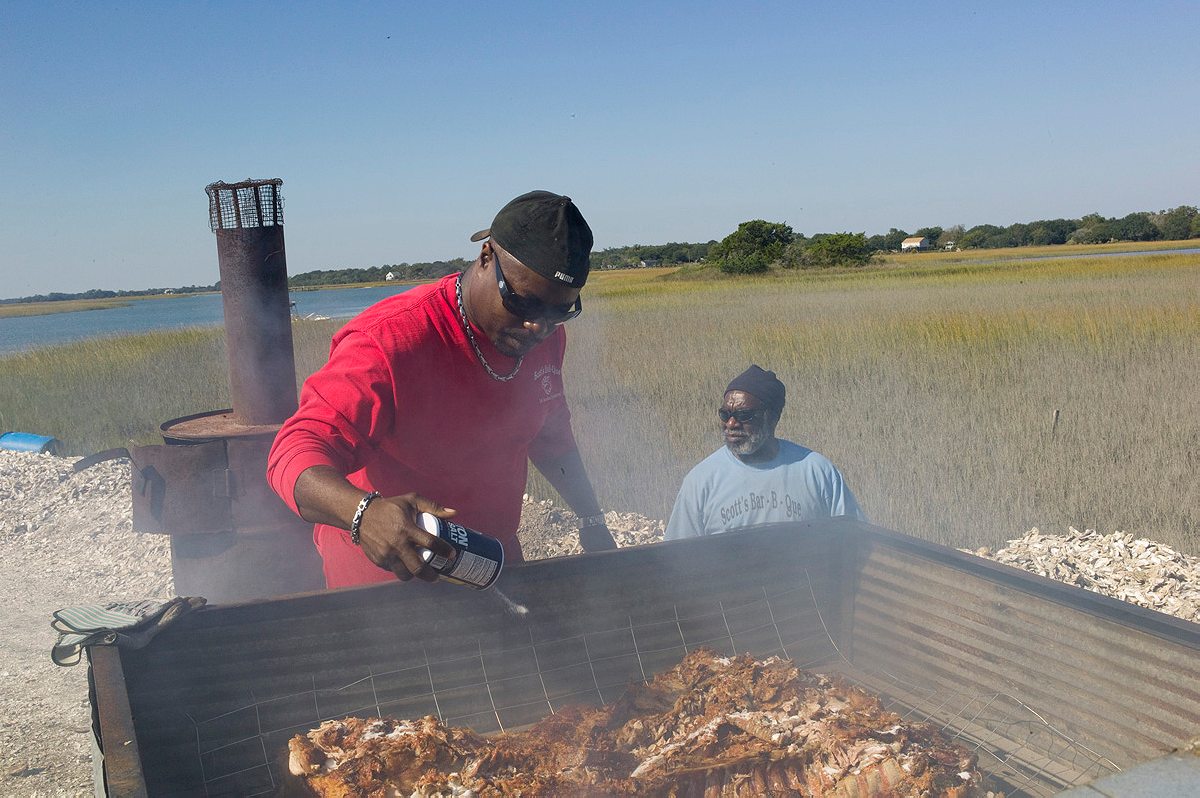
And then Bill Murray walks in, and the whole notion of the celebrity of these chefs sort of withers in comparison. Bill Murray is squeal-as-he-walks-by famous, and on this day at least, he seems needled by it. He’s here with his son and a friend in from Martha’s Vineyard, and he has every right to be here unmolested—he lives in Charleston, he is rumored to be a silent partner in one or more of the city’s many new eateries, and, according to the taxi driver who picked me up from the airport at least, he brought in a potted plant for vegan-friendly soul food joint Alluette’s Café either before or after they named a sandwich after him. But at the BBQ, as in every other place that is not inside his own home, he is cooed at and begged for photos. To those who ask for pictures nicely, like Cook it Raw coordinator/chef Kevin Patricio, he says pleasantly that he’s not doing photos, but he is doing hugs, and then embraces him and plants a long raspberry on his neck. For those less articulate souls, like me in the middle of michelada fever, who just blurt out Bill Murray! stupidly in surprise, he gives a weary look and all of a sudden it seems far more bearable to be chef-famous, that is, anonymous to all except the people who really know what you do and why you do it.
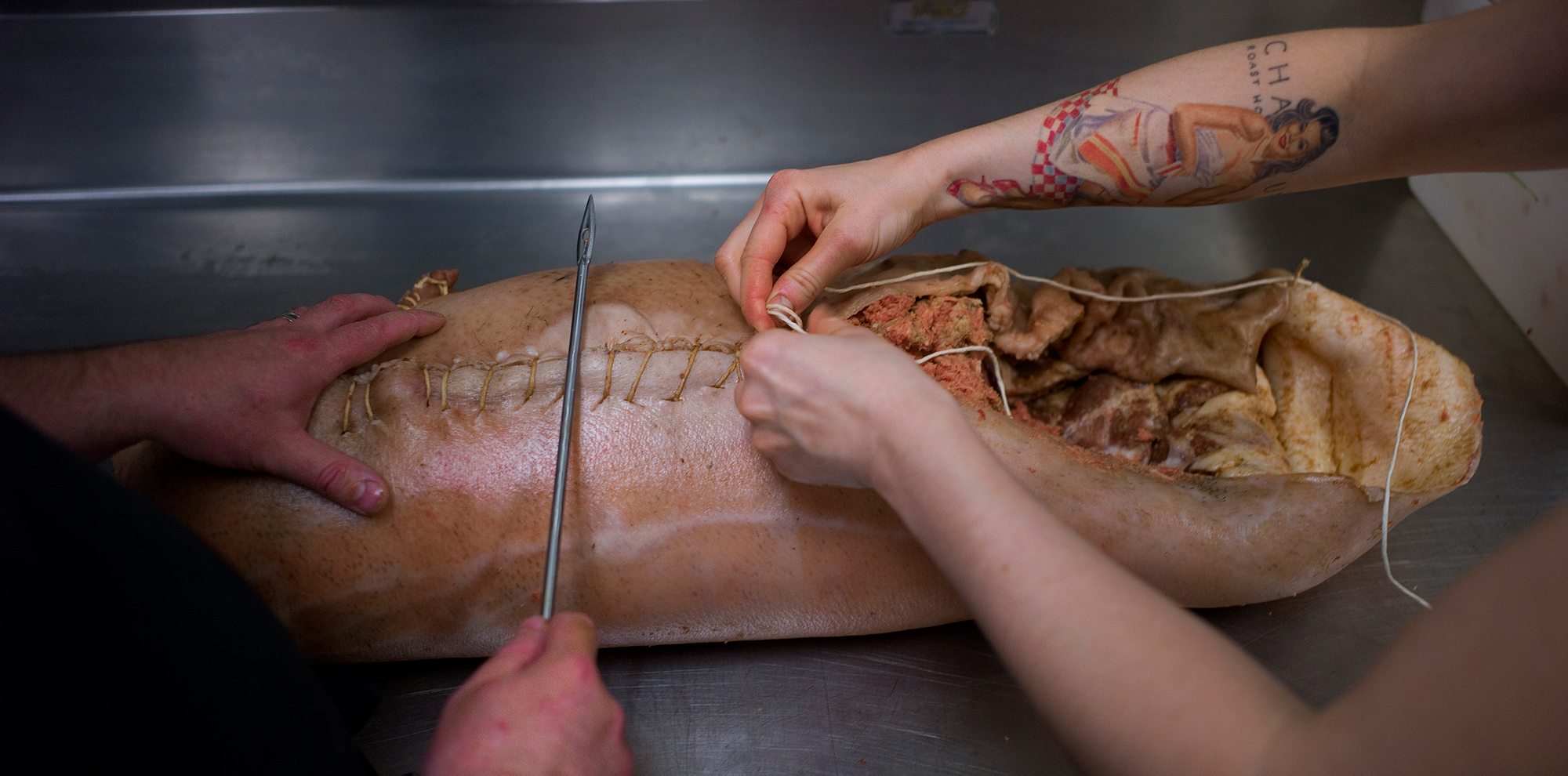
Cook it Raw is the brainchild of Alessandro Porcelli, a former communications officer for Noma in Copenhagen who, Tron-like, escaped the grid of the traditional restaurant business and began a rogue campaign to find meaning in high cuisine. The concept was to bring a small group of global chefs to handpicked locations and make them collaborate on dishes that would connect local ingredients and culture. It started in Denmark, then went to Porcelli’s native Italy, then north to Sweden’s Lapland and to Japan—where Anthony Bourdain’s No Reservations episode put Cook it Raw in the spotlight—then to Poland and finally to the Carolina Lowcountry. The mix of lectures, kitchen work, and excursive foraging, fishing and frolicking missions has remained largely the same, even as other global-chef retreats have emerged to compete. There’s now the MAD Symposium (of which Porcelli is a board member), which is something like the gastropunk version of a Ted talk weekend. Or Gelinaz!, started by Porcelli’s former partner Andrea Petrini, a roving roadshow of starchef-driven food orgies, punctuated by octopus-fellatio and Glassian violin strikes. Cook it Raw remains differentiated by one core ingredient: Porcelli himself, a former semi-pro Italian league basketball player who is endlessly virile, plaintive, emotional, and always steering the event back to the central conversation, which, if I had to sum it up, sort of goes like this: what does food really mean, what if this was all bullshit, but I love you man, and my god isn’t it gorgeous to be alive and right here this moment?
Porcelli’s approach is a rigorously intramural: the chefs are the center of the week, but there are also academics and producers and historians, and when it comes to choosing journalists, the fact that he has invited someone like me, who has spent far more time pondering post-Soviet conflict than charcuterie, shows a bit of his desire to add some element of the unexpected, to challenge the concept, to challenge me.
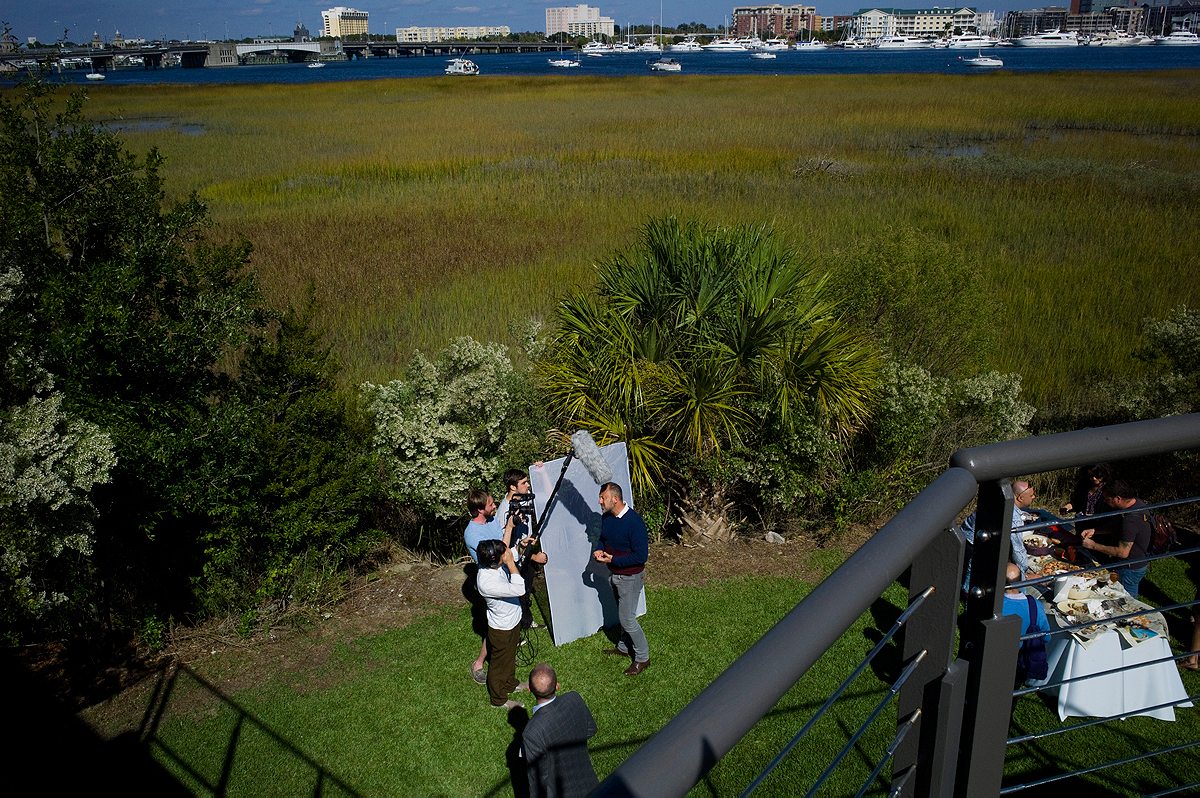
Why Charleston? There are two reasons I might mention. The first is the most technically correct answer: Sean Brock. The executive chef at Husk and McCrady’s lobbied for Charleston to be the home of the sixth Cook it Raw, and it was a clear fit. Though he’s not a native son of Charleston—he’s actually from Virginia—Brock has come to personify the latest rise of the city’s cuisine, and he has a particularly well-suited combination of personas for Cook it Raw. He is a hard-driving, big-drinking, brightly tattooed chef who also has a deep and reverent bookishness when it comes to food heritage and ingredients. Along with grain preservationists like Glenn Roberts of Anson Mills and food historians like David Shields of the University of South Carolina—both of whom figured heavily in the week’s didactic/experiential components—Brock has carved out a notion of Charleston not as just another contemporary American city, but as the ancestral home of the chicken bog and frogmore stew, where loaf sugar sweetens and wormwood brightens, where corn dodgers fry in benne seed oil and rice-fed canvasback ducks roast alongside moon fish and croakers, and the whole thing is washed down with plantation-brewed persimmon beer. The work that has gone into reclaiming the richness of antebellum and 19th century food in Charleston, the kind of cuisine where you can taste the West African mixing with the Caribbean and Colonial, was natural groundwork for Cook it Raw.
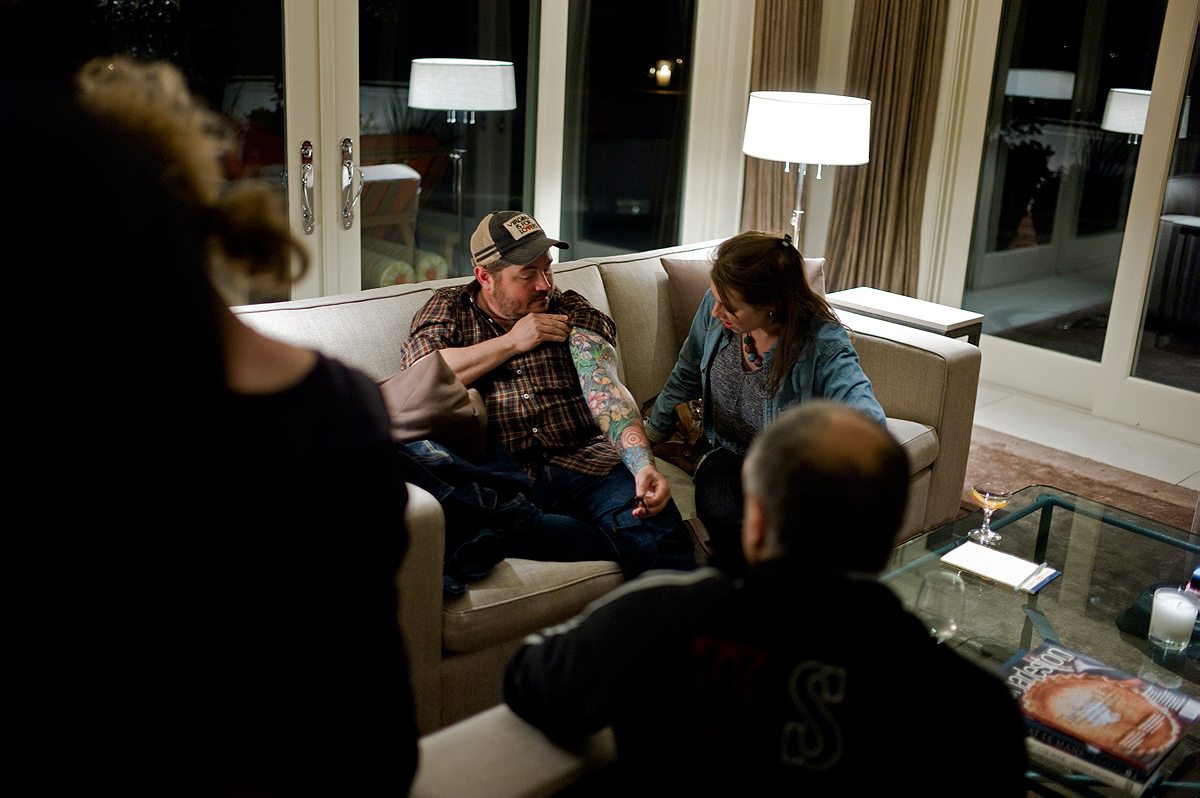
The second answer to the question of why Charleston is this: J. Mike. That’s the first name(s) of the cabbie who takes me, Melbourne megachef Ben Shewry and Phil Woods of Rockpool Sydney on the long drive from the airport to the massive Middleton Place plantation, where we are staying for the week, some 15 miles down the Ashley River from Charleston harbor. It’s twenty minutes of the most food-obsessed cab talk I’ve ever heard, and barely a word of it comes from the chefs. Jay-Mike, nearly without prodding, launches into a hopped-up masterclass on the world of Charleston food: “I love Lowcountry cuisine. I like really good beef barbecue brisket, I like fried green tomatoes with maybe a mango chutney. I like definitely fried flounder. Definitely soul food as long as there’s no pork [he’s not keeping kosher, just thinks pigs unclean]… I’ve eaten at every restaurant that most everyone can name. So everywhere there is, I’ve been at… I’ve rickshawed there, I’ve limoed there… You gotta go to Home, that’s a really cool burger. It’s 25% chuck, 25% brisket, 50% short rib, every meat is shredded differently to bring out the most flavor…. One thing I like about Alluette’s burger, the bread is made at Saffron Bakery… It’s the perfect bread for the burger in my opinion. I went to Burwell’s, and it was brand new, it had just opened up. And I told the guy, I said, ‘I’m gonna be honest.’ Because he’d asked me. I was like, ‘I’ve eaten at over 150 restaurants, I love this burger, but it’s just too dry…’”
A FEW LIONS OF MEXICAN CUISINE ARE GETTING HAMMERED AT A PICNIC BENCH OVERLOOKING THE ASHLEY RIVER
We in the backseat can only raise an eyebrow and laugh: it’s a virtuoso performance of fandom, and from the start it makes the point: this is why Charleston. The city is food-crazed.
We arrive at Middleton Place nearing midnight on Sunday, say our goodbyes to J. Mike, and walk to the sloping sidelawn, where a few lions of Mexican cuisine are getting hammered at a picnic bench overlooking the Ashley River.
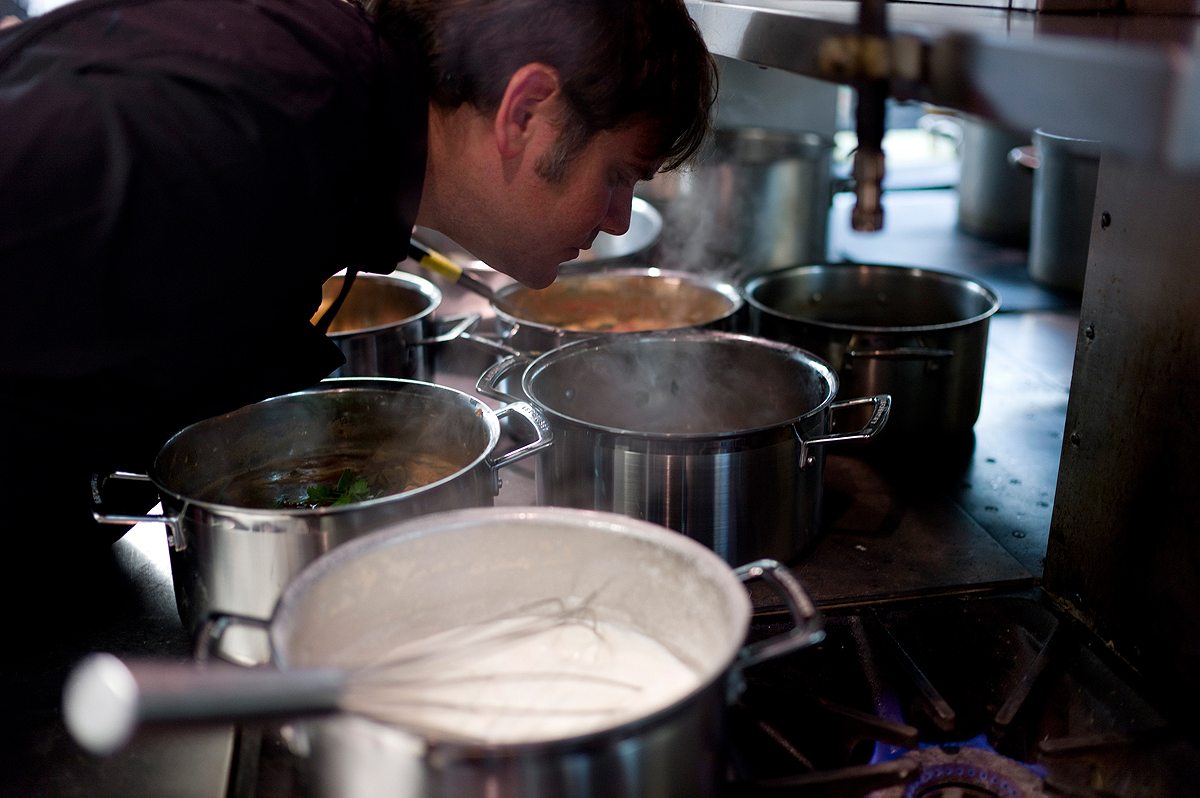
The Mexicans are, from the start, the emotional heart of the week. I use the term Mexicans advisedly, because to lump such varied people together would be a disservice. Roberto Solís is the slightly brooding, soulful mind behind Nectar in Merida. Jair Téllez, who began that first night with half-shouted corridos and whisky from the bottle, comes from a family of lawyers in Tijuana, and studied at St. Mary’s in the Bay Area before finding his way to his revolutionary farm-to-table restaurant in Baja. Alejandro Ruiz, if you sit with him a little while, will tell you some pretty incredible stories about coming from nothing, working at a young age to support his family, and rising to become the father figure of Oaxacan cuisine. Enrique Olvera is most notable for his absence early on in the week—he first sends an assistant in his stead, a studious young cook named Joaquin Cardoso whom the other chefs take to calling licenciado, which means law school graduate and is not generally something men call each other in flattery, though the ribbing was probably aimed more at his boss. But the mood is jovial, both before and after Olvera arrives. Then there’s Werner, who is North American but lives and cooks in Mexico. Or Alex Stupak, who isn’t Mexican but is the chef of New York’s Empellón Cocina in New York. And, of course, as an honorary but completely central member of the group, the only man currently in the process of opening a Mexican-related restaurant: the Catalan Albert Adrià, who spends an entire post-prandial bus ride asking us all for name ideas for his new restaurant in Barcelona. Fandango is suggested on accident because a publicist was talking about movie tickets in a side conversation, but he seems to like the cadence of it. Mucho Mucho gets play because we’ve all been drinking. But in the end, we reach a moment of international comity when we decide that, whether it’s ‘taint’ in English or ‘nies’ in Spanish, the tweener genital part would make the best possible name for any restaurant combining two food traditions. I don’t remember much after that epiphany.
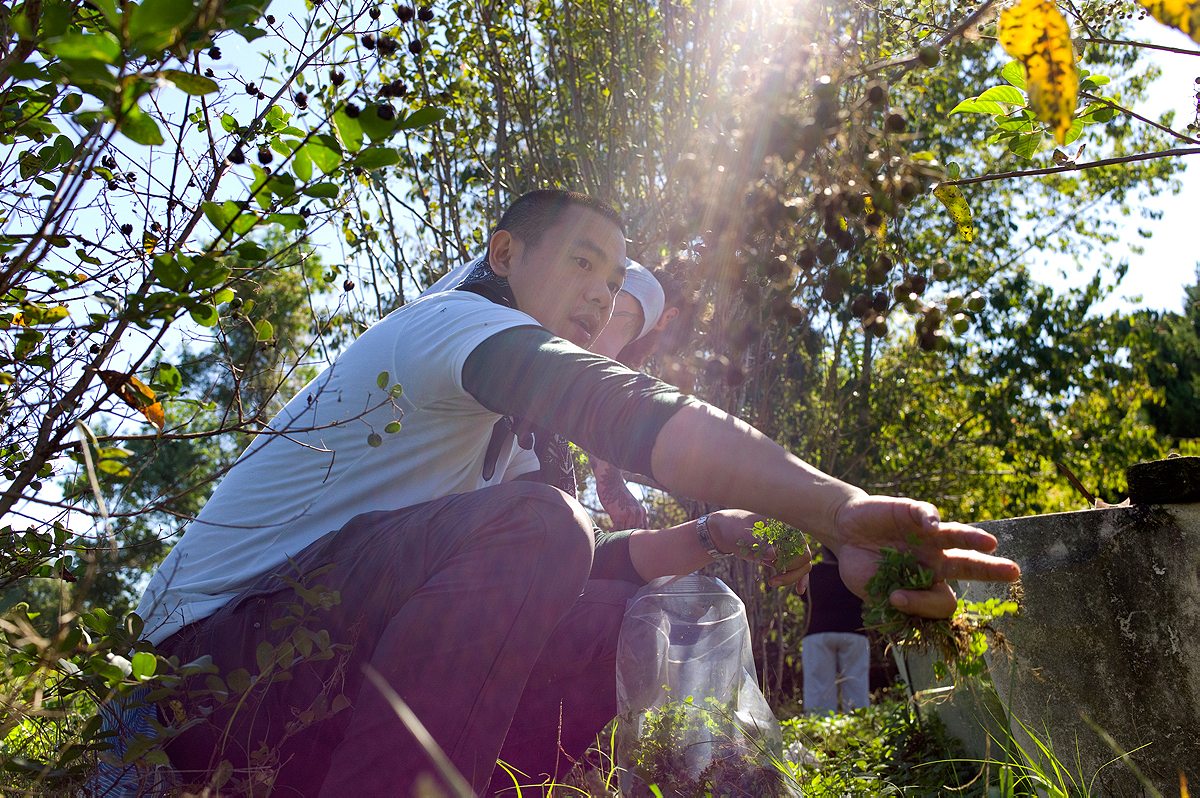
Monday night: the rooms they’ve put us in for the week are sublime. Deep tub, wide bed, a new little giftbox with benne wafers every night. Each room also has a complimentary copy of Beyond the Fields: Slavery at Middleton Place, which enumerates the contours of slavery here and throughout the Lowcountry, the loamy crescent of coastland that extends from the Cape Fear River in North Carolina to the St. John’s River in northern Florida. The Lowcountry can be divided along several fault lines. The historian Shields writes of the regional rubs and marinades: the northern vinegar-and-pepper zone versus the South Carolina mustard-based zone or the later Georgia tomato zone. But beyond the kitchen, into the fields, it was rice, rice, rice that defined this place, and the fact that rice is the most labor-intensive crop of them all, requiring ten times more slaves than cotton, and so throughout the 18th century, there were more slaves than free people in the rice-rich Lowcountry. Of the 14 people who owned more than 500 slaves in the U.S., eight of them lived in this little slice of eastern seaboard.
The book has other details. Slaves from Sengambia and Sierra Leone made expert workers and rice cultivators. The yam-growing Igbo from what is now Nigeria, however, had an alarming tendency to suicide. It’s an unsettling thought, if you had been lulled by the beauty of the place, or thought it a caress when the Spanish moss hanging from the live oak brushed your cheek. In the knowledge of the centuries-long genocide that unfolded here, the plantation seems alive with more than a little malevolence. At a potluck that night on the property, the Gullah spiritualist who blesses the food sits across from me and says that each strand of that Spanish moss is a ghost of a slave who was killed here. “This place is haunted,” she says with a wry smile. “Black people don’t come out here.”
There is an older couple, as white as me, tourists by the look of them, booked in the room next to mine. I wonder about them often as I climb the stairs to my quarters. Did they also get a copy of the slavery book? What do they make of the troupe that has them surrounded? What do they make of Stupak, talking on a cell in front of the rooms near midnight saying quietly but with urgency, “dredge it in marrow”? What do they make of me, up and ill at 3 in the morning, loudly expelling a nights’ worth of heritage grains and bourbon? Surely they didn’t come to Middleton, far down the Ashley River from the more crowded zip codes of Charleston, to suddenly drown in a lake of star chefs and ugly history and queasy journalists?

“The thing about it is there are no assholes here,” says Sasu Laukkonen. ”But that’s a sign of how it is these days. We were brought up to be assholes, by assholes. But now it’s our turn and we’re saying no.”
There’s always that one percent chance, when you survey a room and declare it asshole-free, that you are overlooking something about yourself. But I tend to agree with Laukkonen, a slender Finn who, along with six other younger chefs had applied and won a chance to come cook with idols. He had a point: even Stupak’s permanently arched eyebrow and Dan Barber’s natural aversion to smalltalk seem well-meant. And all of the chefs, in the context of Cook it Raw at least, seem to have put aside whatever barking, demanding, kitchen-riding multitudes they might contain.
I will say this about the era of the asshole chef: at least you knew immediately who the famous ones were. They were the assholes, hard to ignore. Now, it can be difficult to tell who the real heavies are. Because the famous ones these days are like Shewry: wearing cargo shorts, with floppy hair and a sweetness that can’t be coached or bought. Or like April Bloomfield, whom I’ll always remember wearing a knit cap pulled low and just smiling, seraphic, amazing with names, quick to share a joke, as if deliberately countering the base reality that she is one of the most talked-about chefs in America right now. Or like Andre Chiang, flying all the way around the world to be just another cook in a group of many, when back home in Singapore he is the master of so much more. Or like Adrià, who was once described in the New Yorker as being like Braque, by which I think the writer meant that Adrià is inescapably working-class, utterly without pretense. I don’t know the price of these things in Catalunya, but I’d guess Adrià has a $10 haircut and $30 jeans. He dives into the ribaldry of the Mexican contingent, becomes more like them by the day, jokes that in his heart he is Catalan and Spanish and Mexican and American. Whatever shimmering crystalline genius coalesces in his food, Adrià strikes me, as much as anything, as a Great Guy to Have a Beer With, a happy vulgarian with a humble heart.
Adrià is, in a sense, the engine of Cook it Raw. He is the only chef to have been at every Cook it Raw event (Rene Redzepi had gone to everyone once except Charleston). And what chef wouldn’t check their ego at the door of any room Adrià is in? Add Alessandro’s gift for reducing even transactional relationships to some emotional core, and you have something quite unusual. At Cook it Raw, everyone is stripped of rank and retinue for the week. The few media that is invited is wrapped in this as well. There are interview availabilities for local papers, but for the five of us who got this somewhat golden ticket to spend the week living inside the bubble—a Canadian, a Mexican, a Spaniard, an American expat from Paris and myself—there is nothing but Alessandro’s radical openness. This week is meant to be an emotional voyage, narrated and urged forward by Alessandro himself, and he wants no walls for any of us. He wants all to see his bare breast, the beating of his heart, the passion of his collective.
ALESSANDRO APPEARS BEFORE US AT A NEAR-QUAVER AND BEGINS TO SPEAK
There’s probably no better way to describe the agony and ecstasy of being Alessandro than to share a short speech he gives early in the week. Cook it Raw has been accused, not without reason, of cultural blind spots in the past. It took years for a female chef to be included, and even this year, the presence of Bloomfield and a talented Canadian charcuteriste named Connie DeSousa is still counterbalanced by Alessandro’s tendency, at moments of high ardor, to refer gratefully to his staff as “beautiful, sexy ladies”. In Charleston, where we have gathered on a former slave plantation to try to talk deeply about foodways and culture and history, there are no African-Americans or Africans in the core of the group. Rodney Scott was cooking at the BBQ, but he and the cooks at Tuesday’s Gullah night were just role players. Alessandro’s method of dealing with this is not to be defensive or minimize what damage that exclusion might do to the central conceit of the week. Rather, he wants to maximize it, to make it emotional. So, following an afternoon side trip he took to one of the original organic-certified Black farms in the area, he appears before us at a near-quaver and begins to speak.
Why this is happening? We are all here, we are sharing beautiful moments, we are talking about raw materials. And it doesn’t feel right in a way, those beautiful Black people, they came here, to be enslaved. They brought their ingredients, they brought their culture, which this Lowcountry cuisine has been built upon. And I don’t see them here. So I am sad in a way, and I just want to share this sadness with you tonight. Because they are so beautiful. And um, and I just, you know… walking through fields and listening to their stories, it just makes you think about a lot of things, it makes you think about how we treat ourselves as a human, basically, you know? Why are we doing this to ourselves? WHY are we fucking doing this to ourselves? Why don’t we embrace each other? Why don’t we understand each other’s dignity? Not superficially. Why don’t we dig into each other’s history? Why don’t we understand each other more profoundly? But we’re here to celebrate, not to be sad. But really: my heart sank and I fucking cried guys. And this brought also a kind of a sense of hope into this, because we are all here, we are sharing this… But really guys, it’s so beautiful to share with you what food is about from my perspective it’s about emotion, it’s about being fucking real. That’s why I do this, and that’s why I do this for you guys, to share it with you, and I really really hope you bring just a little bit of this with you back home; from the Lowcountry, also from all the countries that came here, to share this with you and to make this happen. Thank you so much.
And with that, he stands at the podium until the hugs come, from Jennings, from Brock, from others, and then we can go back to the ecstasy parts of being Alessandro, like the time when he comes to the breakfast and announces to his table that he had made incredible love to his wife the night before. Which came off as not prurient but just expansive, real, maybe raw, his very Alessandro way of saying: Guys, isn’t this a fucking amazing week?
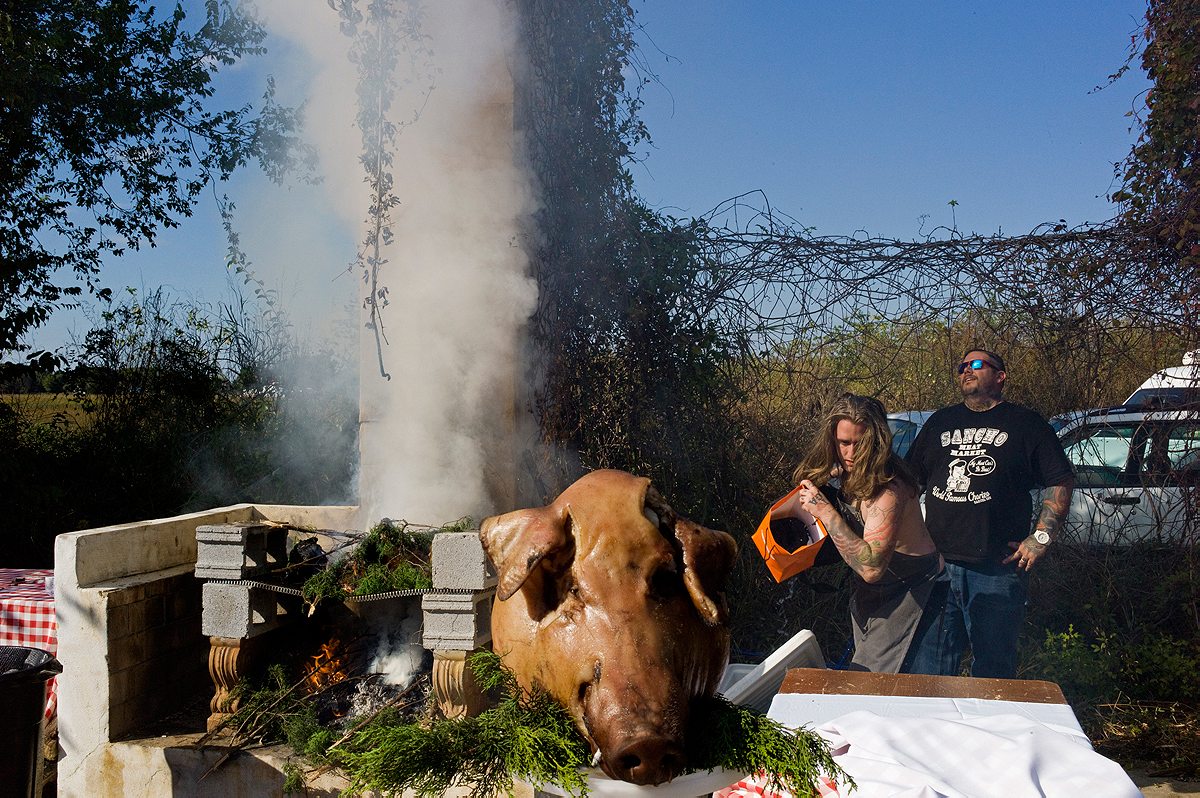
It’s now Tuesday, and Jeremy Charles is tasting myrtle. “Kind of like eating a sweater.” A Newfoundlander with an evocative beard and a deep comfort with silence, Charles was by far the most skilled hunter and fisherman of the group, but when I am with him, on a sort of crab-catching excursion near the Georgia border, he also makes time to craft exquisite little wildflower boutonnieres.
Not far away, Australia-based chefs Woods and Shewry are alongside lanky Dan Barber of Blue Hill at Stone Barns, shoulder-deep in the Carolina Gold rice they’re harvesting. They are with Glenn Roberts, who is clearly energized by the pairing—no one thinks harder or at a higher level in the north about the provenance of ingredients than Barber, and Glenn Roberts has made both a living and cause out of propagating forgotten grains. It’s all a little staged, of course—this rice should have been harvested an age ago, but Roberts had the farmer hold onto it so Cook it Raw could come harvest some. We have come down here, to Turnbridge Plantation, for exactly the sort of speed-dating with traditional lifestyle that is Cook it Raw’s hallmark. There’s a full day of fishing and hunting and cooking at Turnbridge’s hunting lodge. Not that it’s without some problems. I and a few chefs keep losing crab nets in the current. There’s a minor Instagram controversy when one of the chefs stages a deer’s head with a knit cap. The swollen gator tongue is passed around and swung like a phallus from a chef’s pelvis. It’s puerile, in that way that this chef culture can be these days. That’s one of the reasons why Shewry is harvesting rice: He grew up farming in New Zealand, he tells me that morning, and his father wouldn’t think it right to come and shoot a living creature just for the experience of it. I have a similar reaction when it comes to the goat that was killed for the afternoon cookout. I don’t know much about cuisine, but I do know about raising goats, and my uncle, who spent his life raising goats, would not have kept a meat-goat, as this one was, in a large dog crate for a few miserable hours before being led into the woods for messy end (protip: string a goat up and bleed it out, don’t shoot it like it’s a Russian mobster you’re chasing through the Pine Barrens).
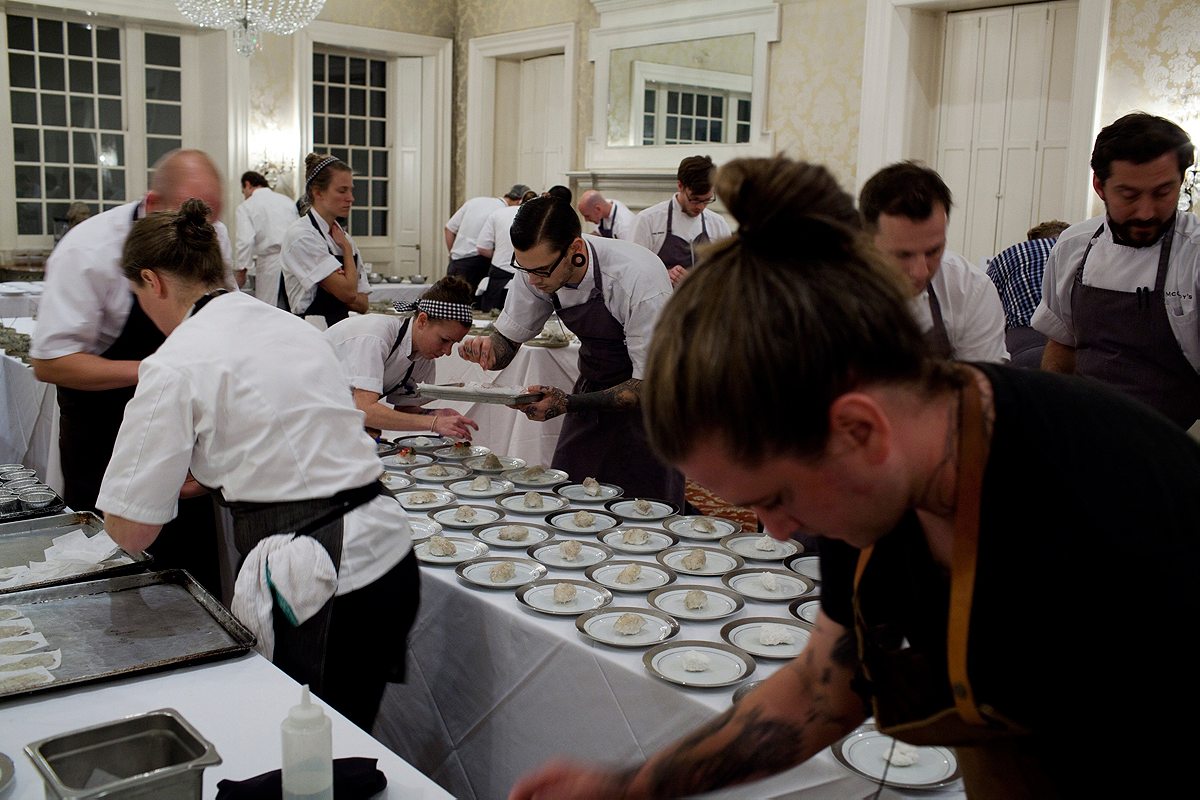
We do eat everything we kill, though, and do so with great pleasure. There are plenty of felicitous moments. The phalanx of ochre-enameled Le Creuset dishes filled with bubbling grits over a woodfire for the early arrival breakfast, is a strangely moving sight. (The cookware company, based in Charleston because it’s one of the closest ports to France, is a Cook it Raw sponsor, as is Breville, who brought in power-juicers and pinpoint induction stoves at the daily breakfast.) The crab boil led by a local guide and caterer and his wife is phenomenal, not least because all the blue crabs moved with palpable anger when the Old Bay snowed down on them in the warming pot. And the vinegar improvisation by Adrià, Solís, Téllez, and others on the alligator tail—it’s really not possible to quick-marinade a gator tail for the grill with huge success, but there’s joy in watching them throw vinegar, tomato, file, yuzu, and olive oil together while drinking beer. Even more impressive is the cleanup routine—while chefs who fly around the world and own restaurants in multiple time zones may pay lip service to being, underneath it all, in the business of serving people, it is not entirely credible until you see them work a cleanup shift with no crew. Behind the hunting lodge, at the long outdoor sink, this is the crew: Bloomfield pours soap into the Le Creusets and scrubs them down along with Werner and Daniel Heinze (McCrady’s chef de cuisine), Shewry dries dishes next to Baltzley and Woods returns the dishes to the lodge upstairs. Charles clears out the coolers full of gator and when all the rest is done, they all move to wiping off and breaking down the crab boil tables and in general I keep thinking these would make a truly elite busboy crew.
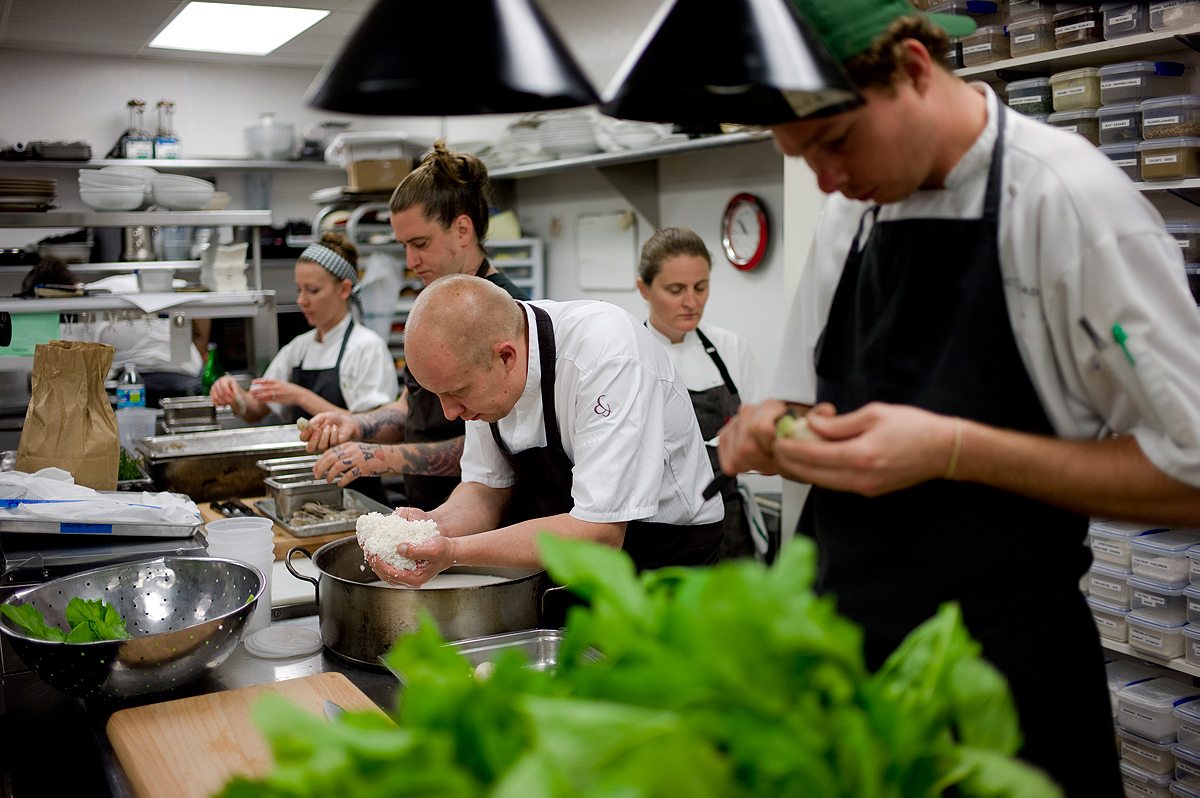
It’s only because I haven’t seen chefs like this work before that I’m impressed by that half-speed performance. The next two days—Wednesday and Thursday of the week—are taken with something approaching the real deal. Cook it Raw isn’t just a fantasy camp for foraging; it’s a place where these chefs get to cook with each other, which culminates with a huge dinner on Thursday night. It’s to be held at McCrady’s, one of Brock’s restaurants, and the chefs have two days to taste and plot and plan and come up with a dish, either solo or in collaboration, that offers their creative interpretation of what they’re seeing/feeling/sensing in Charleston.
After a predawn excursion on Thursday with Heinze and Jennings to forage wild onions near the beach, and a sunrise stop at Dunkin Donuts for coffee and a breakfast sandwich, it’s on to McCrady’s where already a collection of the most ambitious and, in some cases, delicious plates I’ve ever had are already in the planning. The first time I step into the upstairs kitchen, crowded with chefs already, I pass within an inch of Jeremy Charles’ face. He sort of sees me, sort of not. He exhales with a low grunt directed at no one in particular and then moves onward toward the pantry. I feel like I’ve just encountered a bear at very close quarters. James Lowe, a genial chef from the Young Turks in London, comes over to explain. “Do you feel that?” he asks. “It’s like pre-fight. But really good. I like it, how you don’t have to talk to anybody.”
And so I drift through the kitchen and just watch. Werner has some prep cooks taking the feathers off marsh hens using wax and cold water. Laukkonen is popping grains of Carolina gold rice like popcorn and looks absolutely giddy about it. He is partnering with Baltzley, who has shaved for the occasion and is carefully shelling a pile of translucent shrimp. Bloomfield is studying her second order of pork belly before saying that it’s just too fatty—after all, she’ll be serving it with oyster ice cream. Olvera presses a spoon to Stupak’s lips: “Needs salt?” “Yup, a little bit.” Barber and Shewry have spent almost the whole day hunched over a laptop and huddling with Glenn Roberts, and for a while it’s hard to know whether they are preparing a dish or a powerpoint presentation. But now they’re in the kitchen, working on a complex heritage-grain dish, Shewry crushing white pepper with the flat of a knife and talking about the flavor he’s trying to reach. “I’m an acidic motherfucker,” he says. “That’s why I love you,” says Woods. Brock is in the back clowning around with liquid nitrogen for his dish, while Téllez and Ruiz are macerating tomatoes and charring chilies. A McCrady’s staffer—one of the many young chefs who seem to be buzzing everywhere, helping everyone in close quarters with hyper-human efficiency—vacuums for the second time in five minutes. I go downstairs to drink a green concoction called the Emerald City, which has handcrafted spiky ice cubes, and wait for dinner to start.
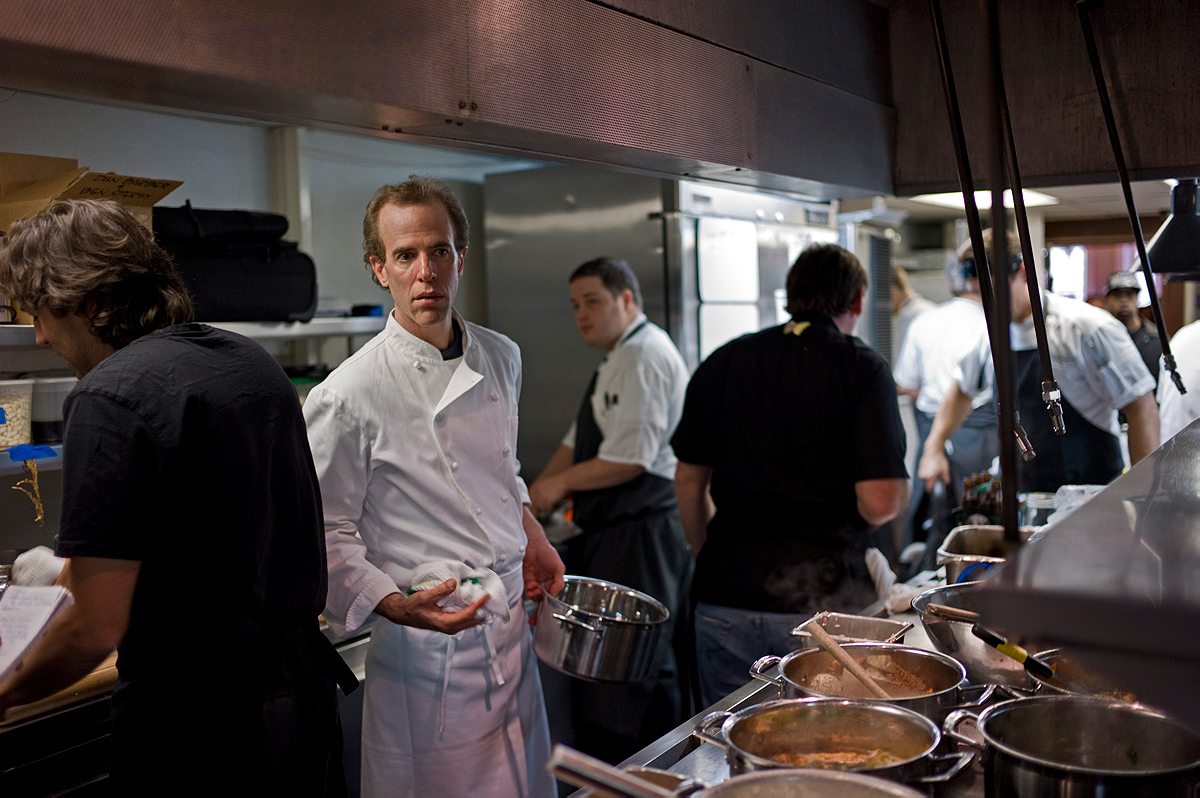
I can’t claim to know the future of Cook it Raw. I know that the next one, later in 2014, will be held in Mexico, which almost guarantees that it will be a phenomenal experience. But the larger context that breathes life to Porcelli’s vision—the one where chefs are stars and Instagram is filled with preciously plated dishes from artisanal auteurs in London, Tokyo, Charleston, Lima and beyond every day—seems so new that one wonders how long that cuisine will support micro-industries like Cook it Raw alongside it. And Porcelli’s idea of connecting this very highwire food experience with deeper questions of history and culture and identity might just be overthinking deliciousness. Sometimes sous vide lamb neck is just sous vide lamb neck. Porcelli also pours so much of himself into each event that one marvels at his stamina so far. At a gathering during the last evening of the week, Cook it Raw organizer/wrangler Arlene Stein, a cynical, funny Torontonian who seems a perfect foil for Porcelli, suggests that he might give a short address to the crowd. “For what?” He pleads with her. “So I can get up there and do another little dance? I can’t. Not now. I’m all out.”
As I write this, Porcelli is in the jungles of the Yucatan looking for food producers whom he might involve when his collective sets down in Mexico next year. It’ll be like that for months on end, often far from his family, hustling for supporters, for sponsors, for inspiration, for this very singular dream of his.
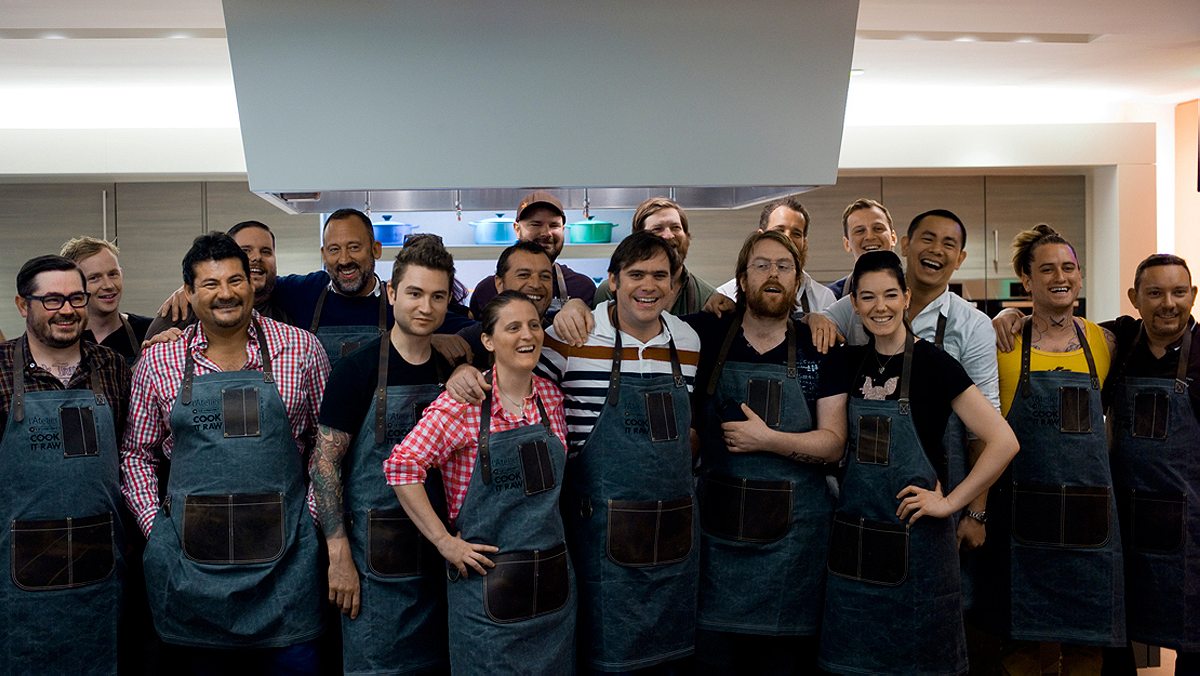
But I will say this: that dinner at McCrady’s—when the nearly two dozen plates of that meal came out of the kitchen, one after the other, and spilled little stories onto each table—it is staggering. Chiang wraps Spanish Moss around a branch in front of a hunter-green pool of kale and sorrel, hiding a perfectly cooked lump of Carolina Gold rice. Adrià produces a magically clear tomato consommé with stone crab. Baltzley and Laukkonen win with a buttery raw shrimp; Téllez’s “Lowcountry aguachile” stitches South Carolina and Mexico together seamlessly. The laptop chefs, Shewry and Barber, ended up creating a conceptual ode to rice, a composition of other rotation crops that make for healthy ricelands, but no rice. It isn’t just instructive or intellectual. It’s also ridiculously well-balanced, a mix of every pleasing note of flavor and texture you could ask for from grains and greens. But there was one dish that seemed to tether the evening just right: the sixth one, by Phil Woods, which was a swordfish from Cherry Point, cured in salt and sugar and crushed red pepper, served with long-braised green beans and a sort of goat cheese risotto. It had the same technical virtuosity of so many of the other dishes, but it was the title of the dish that brought it all back to the beginning for me: Ham for J. Mike.
[Top photo: Matty Mattheson in repose. Photo by: Anthony Suau/©OrganicRisingFilm.com]